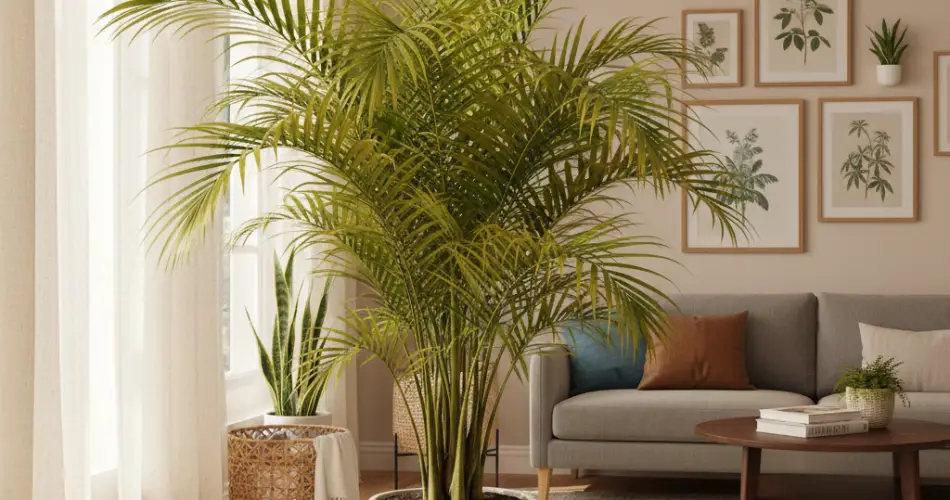The Areca palm (Dypsis lutescens), also known as the butterfly palm or golden cane palm, is a popular indoor and outdoor plant admired for its graceful, feathery fronds and upright, clumping growth habit. With its vibrant green foliage and tropical appeal, it is an excellent choice for homes, offices, patios, or indoor gardens. While this palm is relatively easy to care for, light is a critical factor that directly affects its growth, foliage color, and overall health.
Understanding the ideal lighting conditions for Areca palms can help prevent yellowing fronds, stunted growth, or sunburn while ensuring lush, healthy greenery year-round.
Natural Habitat and Light Adaptation
Areca palms are native to Madagascar and thrive in tropical and subtropical climates. In their natural environment, they grow under forest canopies, receiving bright, filtered sunlight rather than direct, harsh rays. This adaptation makes Areca palms highly versatile—they can tolerate indoor light and shaded areas, yet they flourish when provided with bright, indirect sunlight.
Bright, Indirect Light: Ideal Indoor Conditions
Areca palms thrive in bright, indirect light, which encourages strong, upright growth and maintains vibrant, green fronds. Proper light helps the palm produce new foliage consistently, ensuring a full, healthy appearance.
Indoor placement tips for bright, indirect light:
-
East-facing windows: Gentle morning sunlight promotes steady growth without risking frond damage.
-
North-facing windows: Provide consistent moderate light for indoor growth.
-
South- or west-facing windows with filtered light: Use sheer curtains or position the palm several feet away from the glass to prevent scorching.
With these placements, the Areca palm maintains its lush, tropical appearance while avoiding common problems caused by direct sun exposure.
Low Light Tolerance
One of the reasons Areca palms are popular indoor plants is their ability to tolerate low-light conditions. This makes them ideal for offices, hallways, and rooms that do not receive abundant sunlight.
In low-light conditions, you may notice:
-
Slower growth and fewer new fronds.
-
Slightly paler leaves with reduced vibrancy.
-
Fronds may elongate as the plant stretches toward light sources.
While the palm survives in low-light areas, growth will be slower, and the plant may appear less full. Relocating to a brighter spot or supplementing with artificial lighting can restore vibrant growth.
Direct Sunlight: Avoiding Damage
Although Areca palms enjoy brightness, direct sunlight can harm the plant, particularly indoors. Intense rays from south- or west-facing windows may scorch the fronds, leaving brown tips, yellowing leaves, and dry patches.
To protect the plant:
-
Place it several feet away from direct sun.
-
Use sheer curtains to filter sunlight.
-
Gradually acclimate the palm if moving it from a low-light to a bright-light area.
Protecting the palm from direct sun preserves its lush green fronds and prevents long-term damage.
Outdoor Light Requirements
When grown outdoors in warm climates, Areca palms flourish in partial shade or filtered sunlight. While they can tolerate morning or late afternoon sun, prolonged exposure to direct midday sunlight may damage fronds.
Outdoor placement tips:
-
Morning sun exposure is ideal, especially in warmer climates.
-
Place under taller trees or structures for dappled sunlight.
-
Avoid full sun during the hottest hours to prevent leaf burn.
Gradually acclimating indoor-grown palms to outdoor sunlight ensures healthy growth without stress or scorching.
Artificial Lighting for Indoor Growth
In homes or offices with limited natural light, Areca palms respond well to artificial lighting. LED or fluorescent grow lights can provide sufficient intensity to maintain healthy growth and vibrant fronds.
Tips for artificial lighting:
-
Use full-spectrum lights to mimic natural sunlight.
-
Position lights 12–18 inches above the plant.
-
Provide 10–12 hours of light per day for optimal growth.
Artificial lighting allows Areca palms to thrive even in windowless areas or during the winter months when natural light is limited.
Seasonal Light Adjustments
Light availability changes with the seasons, so adjustments may be needed:
-
Summer: Protect the palm from harsh afternoon sun outdoors or indoors.
-
Winter: Place closer to bright windows or supplement with artificial lighting to compensate for shorter daylight hours.
Rotating the palm periodically ensures even growth and prevents leaning toward a single light source.
Signs of Incorrect Light
Your Areca palm provides visible signals if its light needs are unmet:
-
Too little light: Slow growth, pale or yellow fronds, and elongated stems.
-
Too much direct light: Scorched fronds, brown tips, and dry leaves.
-
Optimal light: Lush, vibrant green fronds with steady growth and dense foliage.
Observing these signs allows you to adjust the palm’s placement promptly to maintain healthy growth.
Final Thoughts
Areca palms are elegant, adaptable plants that bring tropical beauty to both indoor and outdoor environments. While they tolerate low-light conditions, they thrive in bright, indirect light, which encourages vigorous growth, lush green fronds, and an attractive, full appearance.
By placing your Areca palm near east- or north-facing windows, filtering south- or west-facing light, or supplementing with artificial lighting when necessary, you can ensure healthy growth year-round. With proper light care, this versatile palm will enhance any space with its tropical elegance and air-purifying benefits, providing a vibrant, lush focal point in your home or office.



